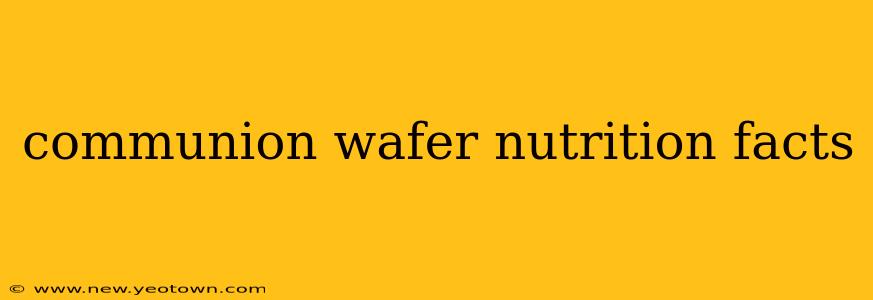The humble communion wafer, a symbol of faith and spiritual nourishment for millions, often sparks curiosity about its nutritional content. While its primary purpose is deeply rooted in religious practice, understanding its nutritional makeup can be surprisingly interesting. This post delves into the nutritional facts of a communion wafer, answering common questions and providing insights into its composition.
Let's begin our journey by understanding that the nutritional profile of a communion wafer can vary depending on the manufacturer and the ingredients used. However, generally, they consist primarily of simple carbohydrates.
What are the main ingredients in a communion wafer?
The primary ingredients in most communion wafers are wheat flour, water, and sometimes a small amount of salt. Some manufacturers may include other ingredients, such as leavening agents to make them slightly puffier. However, the goal is always to create a simple, unleavened bread, mirroring the historical practice of using simple ingredients for this sacred ritual. Variations exist across denominations and regions, but the core remains simple and unadorned.
How many calories are in a communion wafer?
A single, small communion wafer typically contains between 5 and 15 calories. The exact calorie count depends heavily on the size and the manufacturer's recipe. These calories primarily come from the carbohydrates in the wheat flour. Because the wafers are so small and contain minimal added ingredients, the caloric impact is negligible.
Are communion wafers gluten-free?
No, traditional communion wafers are generally not gluten-free. They are made from wheat flour, a significant source of gluten. For individuals with celiac disease or gluten intolerance, it's crucial to seek out specifically labeled gluten-free communion wafers, which are becoming increasingly available from religious supply stores and some specialty bakeries. Always verify the ingredient list to ensure it meets your dietary needs.
Do communion wafers contain any vitamins or minerals?
Communion wafers provide minimal vitamins and minerals. While wheat flour does contain some trace amounts of nutrients, the quantity in a single wafer is insignificant from a nutritional standpoint. Its role is primarily symbolic and ritualistic rather than dietary.
What is the glycemic index of a communion wafer?
The glycemic index (GI) of a communion wafer is likely to be relatively high due to the nature of the simple carbohydrates present in wheat flour. However, the small size of the wafer means the overall impact on blood sugar is minimal for most individuals.
Are there any potential health concerns related to consuming communion wafers?
For most people, consuming communion wafers presents no significant health concerns. However, individuals with allergies to wheat or other ingredients should exercise caution and check the ingredient list carefully. Those with celiac disease or gluten intolerance must seek gluten-free alternatives.
Where can I find gluten-free communion wafers?
Many religious supply stores now carry gluten-free communion wafers. You may also find them through online retailers specializing in gluten-free products or by contacting your local church or religious community. Always carefully read the product label to confirm the absence of gluten and any potential cross-contamination during manufacturing.
In conclusion, while the communion wafer holds immense spiritual significance, its nutritional value is minimal. Its simplicity and symbolic importance are far more significant than its impact on a person’s daily dietary intake. Understanding its composition, however, empowers individuals with dietary restrictions to make informed choices and participate in communion meaningfully.

